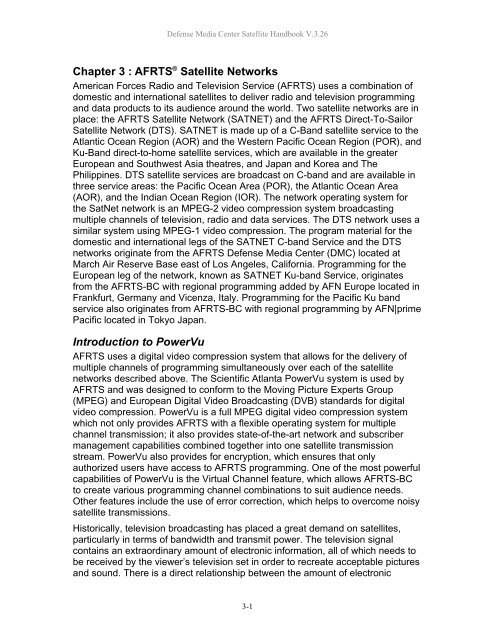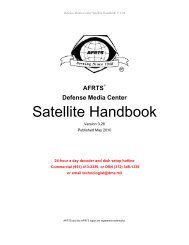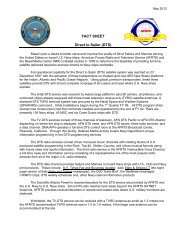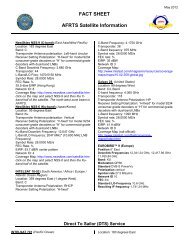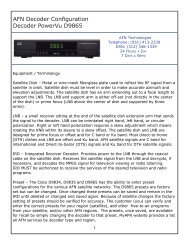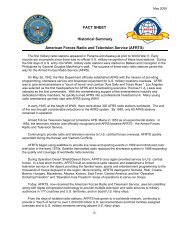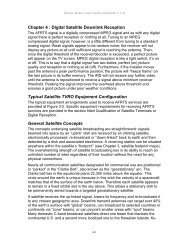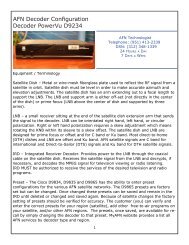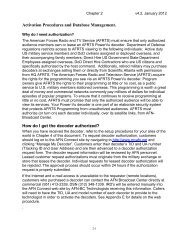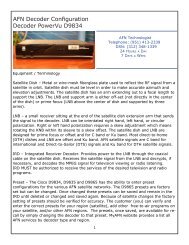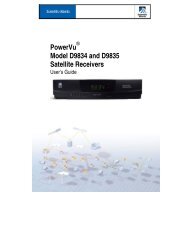AFRTS Defense Media Center Satellite Handbook
AFRTS Defense Media Center Satellite Handbook
AFRTS Defense Media Center Satellite Handbook
Create successful ePaper yourself
Turn your PDF publications into a flip-book with our unique Google optimized e-Paper software.
<strong>Defense</strong> <strong>Media</strong> <strong>Center</strong> <strong>Satellite</strong> <strong>Handbook</strong> V.3.26<br />
Chapter 3 : <strong>AFRTS</strong> ® <strong>Satellite</strong> Networks<br />
American Forces Radio and Television Service (<strong>AFRTS</strong>) uses a combination of<br />
domestic and international satellites to deliver radio and television programming<br />
and data products to its audience around the world. Two satellite networks are in<br />
place: the <strong>AFRTS</strong> <strong>Satellite</strong> Network (SATNET) and the <strong>AFRTS</strong> Direct-To-Sailor<br />
<strong>Satellite</strong> Network (DTS). SATNET is made up of a C-Band satellite service to the<br />
Atlantic Ocean Region (AOR) and the Western Pacific Ocean Region (POR), and<br />
Ku-Band direct-to-home satellite services, which are available in the greater<br />
European and Southwest Asia theatres, and Japan and Korea and The<br />
Philippines. DTS satellite services are broadcast on C-band and are available in<br />
three service areas: the Pacific Ocean Area (POR), the Atlantic Ocean Area<br />
(AOR), and the Indian Ocean Region (IOR). The network operating system for<br />
the SatNet network is an MPEG-2 video compression system broadcasting<br />
multiple channels of television, radio and data services. The DTS network uses a<br />
similar system using MPEG-1 video compression. The program material for the<br />
domestic and international legs of the SATNET C-band Service and the DTS<br />
networks originate from the <strong>AFRTS</strong> <strong>Defense</strong> <strong>Media</strong> <strong>Center</strong> (DMC) located at<br />
March Air Reserve Base east of Los Angeles, California. Programming for the<br />
European leg of the network, known as SATNET Ku-band Service, originates<br />
from the <strong>AFRTS</strong>-BC with regional programming added by AFN Europe located in<br />
Frankfurt, Germany and Vicenza, Italy. Programming for the Pacific Ku band<br />
service also originates from <strong>AFRTS</strong>-BC with regional programming by AFN|prime<br />
Pacific located in Tokyo Japan.<br />
Introduction to PowerVu<br />
<strong>AFRTS</strong> uses a digital video compression system that allows for the delivery of<br />
multiple channels of programming simultaneously over each of the satellite<br />
networks described above. The Scientific Atlanta PowerVu system is used by<br />
<strong>AFRTS</strong> and was designed to conform to the Moving Picture Experts Group<br />
(MPEG) and European Digital Video Broadcasting (DVB) standards for digital<br />
video compression. PowerVu is a full MPEG digital video compression system<br />
which not only provides <strong>AFRTS</strong> with a flexible operating system for multiple<br />
channel transmission; it also provides state-of-the-art network and subscriber<br />
management capabilities combined together into one satellite transmission<br />
stream. PowerVu also provides for encryption, which ensures that only<br />
authorized users have access to <strong>AFRTS</strong> programming. One of the most powerful<br />
capabilities of PowerVu is the Virtual Channel feature, which allows <strong>AFRTS</strong>-BC<br />
to create various programming channel combinations to suit audience needs.<br />
Other features include the use of error correction, which helps to overcome noisy<br />
satellite transmissions.<br />
Historically, television broadcasting has placed a great demand on satellites,<br />
particularly in terms of bandwidth and transmit power. The television signal<br />
contains an extraordinary amount of electronic information, all of which needs to<br />
be received by the viewer’s television set in order to recreate acceptable pictures<br />
and sound. There is a direct relationship between the amount of electronic<br />
3-1


